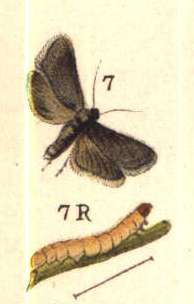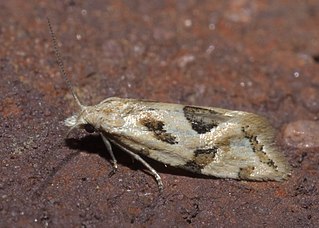
Cydia is a large genus of tortrix moths, belonging to the tribe Grapholitini of subfamily Olethreutinae. Its distinctness from and delimitation versus the tribe's type genus Grapholita requires further study.

Epermeniidae or the fringe-tufted moths is a family of insects in the lepidopteran order with about 14 genera. Previously they have been divided in two subfamilies Epermeniinae and Ochromolopinae but this is no longer maintained since the last group is probably hierarchically nested within the first. They are presently placed in their own superfamily but have previously been placed among the Yponomeutoidea or Copromorphoidea with which they share some features. Their systematic placement among the apoditrysian group "Obtectomera" is however uncertain. They show some morphological similarities to the "plume moths", for example the wing fringe has similar groups of scales. There are also some similarities to Schreckensteinioidea, for example spiny legs and at least in some species an open-network cocoon. The genus Thambotricha from New Zealand may be the sister group of all other extant members. The most important genera are Epermenia, Ochromolopis and Gnathifera. The group has been extensively revised and catalogued by Dr Reinhard Gaedike.

Loxostege sticticalis is a species of moth of the family Crambidae. It was first described by Carl Linnaeus in 1761 and is found in the Palearctic and Nearctic realms.

Loxostege is a genus of moths of the family Crambidae.

Grapholita is a large genus of tortrix moths. It belongs to subfamily Olethreutinae, and therein to the tribe Grapholitini, of which it is the type genus.

Aethes is a genus of moths belonging to the subfamily Tortricinae of the family Tortricidae.

Cochylis is a genus of moths belonging to the subfamily Tortricinae of the family Tortricidae.

Oidaematophorus lithodactyla, also known as the dusky plume, is a moth of the family Pterophoridae found from Europe to Asia Minor and Japan. It was first described by German lepidopterist, Georg Friedrich Treitschke in 1833.

Metasia ophialis is a species of moth of the family Crambidae.

Agonopterix is a moth genus of the superfamily Gelechioidea. It is placed in the family Depressariidae, which was often – particularly in older treatments – considered a subfamily of the Oecophoridae or included in the Elachistidae.
Stemmatophora honestalis is a species of snout moth in the genus Stemmatophora. It was described by Georg Friedrich Treitschke in 1829. It is found in Spain and on the Balkan Peninsula and North Africa.
Loxostege ephippialis is a species of moth in the family Crambidae. It was described by Johan Wilhelm Zetterstedt in 1839. It is found in Norway, Sweden, Finland, Russia and North America.

Aethes rubigana, the burdock conch, is a moth of the family Tortricidae. It was described by Treitschke in 1830. It is found in most of Europe, except the Iberian Peninsula and part of the Balkan Peninsula. Outside of Europe, it is found in China, Japan and Russia.
Gnophini is a tribe of moths.











